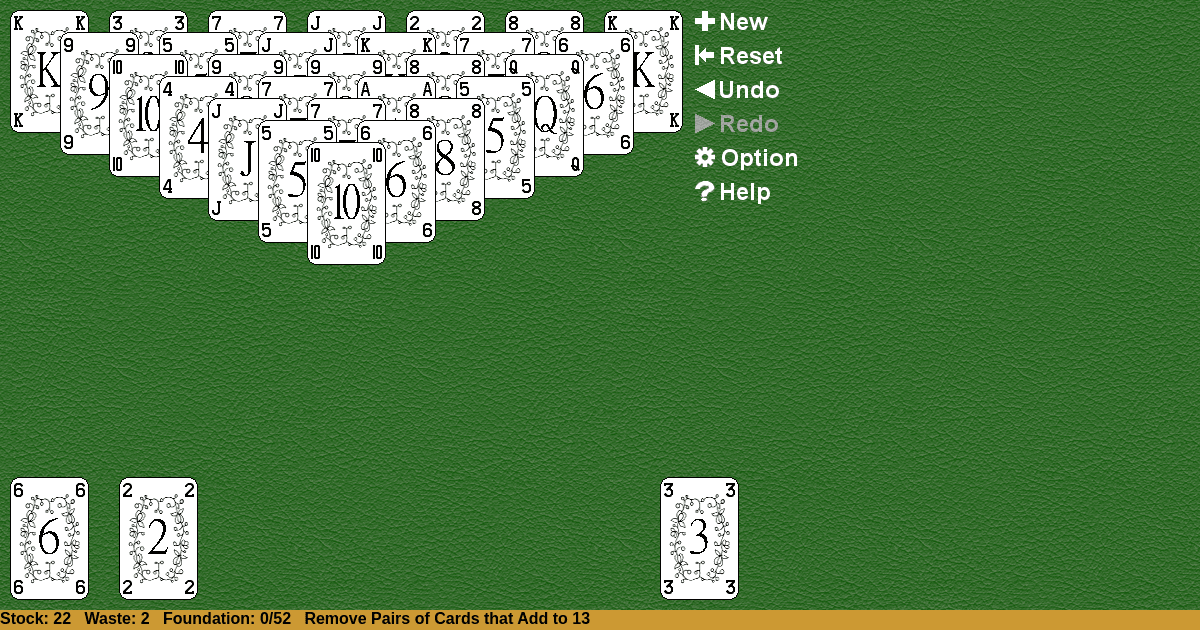Triangle
Home |
How to play |
FAQ |
About
How to play Triangle?
Game Objective:
The primary goal in Triangle Solitaire (commonly known as Pyramid Solitaire) is to remove all cards from the pyramid by pairing uncovered cards whose values sum to 13. Kings, valued at 13, are removed individually.
Setup & Layout:
- Deck: Use a standard 52-card deck (no jokers).
- Pyramid Tableau: Deal 28 cards face-up in a pyramid shape:
- Row 1 (top): 1 card
- Row 2: 2 cards (overlapping the first row)
- Continue, increasing by one card per row, until Row 7 has 7 cards.
- Stock: Place the remaining 24 cards face-down in a single pile beside the pyramid. This is the stock.
- Waste Pile: As cards are drawn from the stock, any unpaired card is placed face-up in the waste pile.
- Foundations: There are no traditional foundations; removed cards are placed in a discard or foundation area.
Key Play Areas:
- Pyramid: The main tableau of 28 face-up cards arranged in overlapping rows.
- Stock: The face-down pile of undealt cards.
- Waste: The face-up pile for stock cards not immediately paired and removed.
Triangle Solitaire Rules:
- Card Values:
- Ace = 1
- Number cards = face value (2–10)
- Jack = 11
- Queen = 12
- King = 13
- Pairing:
- Remove pairs of uncovered cards whose values total 13 (e.g., 8 + 5, 10 + 3).
- Kings (13) are removed individually as a single card.
- Exposed Cards:
- Only cards not overlapped by any other card (i.e., fully uncovered) are available for pairing or removal.
- Stock and Waste:
- Draw one card at a time from the stock.
- The top card of the waste pile can be paired with an exposed pyramid card or the next drawn stock card if their sum is 13.
- Sequence Building:
- There is no sequence building by suit or color; only pairing by value is permitted.
Gameplay:
- Turn Sequence:
- Remove any available pairs of exposed cards in the pyramid that sum to 13.
- Remove any exposed King immediately.
- If no pairs are available, draw the top card from the stock and attempt to pair it with an exposed pyramid card or the top card of the waste pile.
- If the drawn card cannot be paired, place it face-up on the waste pile.
- Continue drawing from the stock and pairing as possible.
- Stock & Waste Mechanics:
- Only the top card of the waste pile is available for pairing.
- In some rule sets, you may pass through the stock only once; others allow one or more redeals (check specific variant rules).
- No More Moves:
- If no further pairs are possible and the stock is exhausted, the game ends.
Winning & Losing Conditions:
- Win: Successfully remove all cards from the pyramid (and, in some stricter variants, also clear the waste pile).
- Lose: The game is lost if no more legal moves are possible and cards remain in the pyramid.
Special Rules & Edge Cases:
- Filling Spaces: There is no filling of empty spaces in the pyramid; once a card is removed, the space remains empty.
- Redeals: Some variants allow the waste pile to be turned over and used as a new stock one or more times; traditional rules typically permit only a single pass through the stock.
- Pairing Restrictions: Only fully uncovered cards (not overlapped by any card) may be paired or removed.
- Stock/Waste Pairing: The top card of the waste pile and the next card drawn from the stock may be paired if their sum is 13.
- Unwinnable States: If the pyramid cannot be cleared due to lack of available pairs and the stock is exhausted, the game is unwinnable.
Note: "Triangle Solitaire" is widely recognized as "Pyramid Solitaire." If you are seeking a different variant with unique mechanics, please clarify for a more tailored guide.

Solitaire Collection
About Triangle
Rate (Triangle)
4.7 / 5
1,916 votes



























































